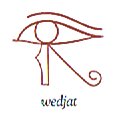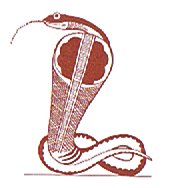|
TRANSLATIONS
I happened to notice that there was a goddess named Wadjet in Lower Egypt. From Wedjat to Wadjet is just a small step I thought, maybe Wadjet is the reversal of Wedjat? On the other hand, the vocals did not carry any meaning and therefore Wadjet should be the same word as Wedjat - wdjt. The same word, the same meaning. Both words end with -t and wdjt must be feminine, the wife of somebody (wdj?). According to Wilkinson Wadjet was a snake goddess and we can see her depicted in the hieroglyph iaret:
"The Greek word from which the Latin urŠus is derived may have its origin in the Egyptian expression 'she who is raising herself up', which characterizes the Egyptian cobra (Naja haje) with outstretched shield in its typical position of attack. The species early became associated with the sun, with the kingdom of Lower Egypt, with pharaoh and with a number of godly personages.
As the animal sacred to the goddess Wadjet in the city of Buto in the delta of the Nile the cobra became an emblem for Lower Egypt and appears together with the vulture of Upper Egypt (Nechbet) in the nebty- or 'Two Ladies' title." The 'spiral' at bottom right in the wedjat glyph perhaps represents the tail of wadjet:
UrŠus ... representation of the sacred asp or serpent on the headdress of ancient Egyptian deities and kings ... Gr. ouraţos (Horapollo) ... Egyptian. perh. infl. by Gr. ourā tail. (English Etymology) But the line in wedjat is straight, maybe the line with spiral is a composite, the tail of the serpent (like the hole from which she crept up) + the straight shaft of the was sceptre. We can see twin was sceptres above, one at right (leaning 45░ as in wedjat) and the other at left leaning in the opposite direction). The was sceptres held the sky (pet) up:
The was sceptre in the claw of the vulture is inserted into the schen (eternity) hole, as if to indicate the exit door in the west. The schen hole in the east is above the was sceptre. Why the difference? Wedjat and Wadjet are the same. The pupil in wedjat is the shield of the cobra and the 'arm' lifting the sun shield is the body of the snake. At this point we should remember that the head gear representing Lower Egypt also has the straight line with a spiral:
The 'Two Ladies' (Wadjet at left) evidently protect the sun god during his travel across the sky, and one cannot help wondering if not the two circular emblems in the middle are the 'holes' through which sun enters and leaves. On the other hand, the scarab appears to have entered through the door at center bottom. Furthermore, the twin circular schen emblems - according to Wilkinson - symbolize eternity (and I associate to the Greek letter omega, Ω.) Both was sceptres are this time in front of schen. The Upper Egypt schen (right) incorporates two straight staffs, the one at left (Lower Egypt) has one only. Probably this means that the 1st period of the day (Lower Egypt, Wadjet) is symbolized by 1 staff, while the 2nd period of the day should have 2 staffs. A period of time was illustrated by a wooden staff also in ancient Egypt, it seems. But why is the straight line + scroll (my intuition tells me to use this word instead of spiral) not straight any more and why is the scroll on top instead of at bottom? I think we must eliminate the explanation that the 'straight line' is the shaft of was. As in the picture Lower Egypt is at left and the composition is dominated by the rhomb of wings, the wedjat sign in the head gear must be leaning this way. Unless the scroll is put on top it would not be visible (being inside the hat). If Lower Egypt (Wadjet) corresponds to the 1st half of the day and and Upper Egypt (Nechbet) to the 2nd half, then the 'snake' (like the rainbow) announces that darkness is over, a function suitable for east. The 'vulture' should be located in the west, taking care of the 'dead body'. We remember Rb1-105:
'... Embalming is known and practised with surprising skill in one particular family of chiefs. Unlike the Egyptian method, as described by Herodotus, it is performed in Samoa exclusively by women. The viscera being removed and buried, they, day after day, anoint the body with a mixture of oil and aromatic juices. To let the fluids escape, they continue to puncture the body all over with fine needles. In about two months, the process of desiccation is completed. The hair, which had been cut and laid aside at the commencement of the operation, is now glued carefully on to the scalp by a resin from the bush. The abdomen is filled up with folds of native cloth; the body is wrapped up with folds of the same material, and laid out on a mat, leaving the hands, face, and head exposed. ...' Like the scarab the snake appears from the underground through some hole, and maybe the twin 'holes' are used both for the sun and for the snake?
In the Dogon temple there are both twin holes and a door, just as in the Egyptian picture. Shouldn't that mean that the snake (female) is using the twin holes, while the sun (male) is using the central door for his entrance? 1 is universally the symbol of the male (member), while 2 is the symbol of the female (breasts?). Anyhow, the snake appearing from the underworld is spitting fire:
We now understand what the 'stylized arm' in GD32 really depicts, a fire-spitting snake, with 'elbow' ('joint' between 'snake' and 'human') at left as in the Egyptian hieroglyph:
'... Water, which is the divine seed, was thus able to enter the womb of the earth and the normal reproductive cycle resulted in the birth of twins. Two beings were thus formed. God created them like water. They were green in colour, half human beings and half serpents. From the head to the loins they were human: below that they were serpents. Their red eyes were wide open like human eyes, and their tongues were forked like the tongues of reptiles. Their arms were flexible and without joints. Their bodies were green and sleek all over, shining like the surface of water ...' '... The Katawihi distinguish two rainbows: Mawali in the west, and Tini in the east. Tini and Mawali were twin brothers who brought about the flood that inundated the whole world and killed all living people, except two young girls whom they saved to be their companions ...' |







